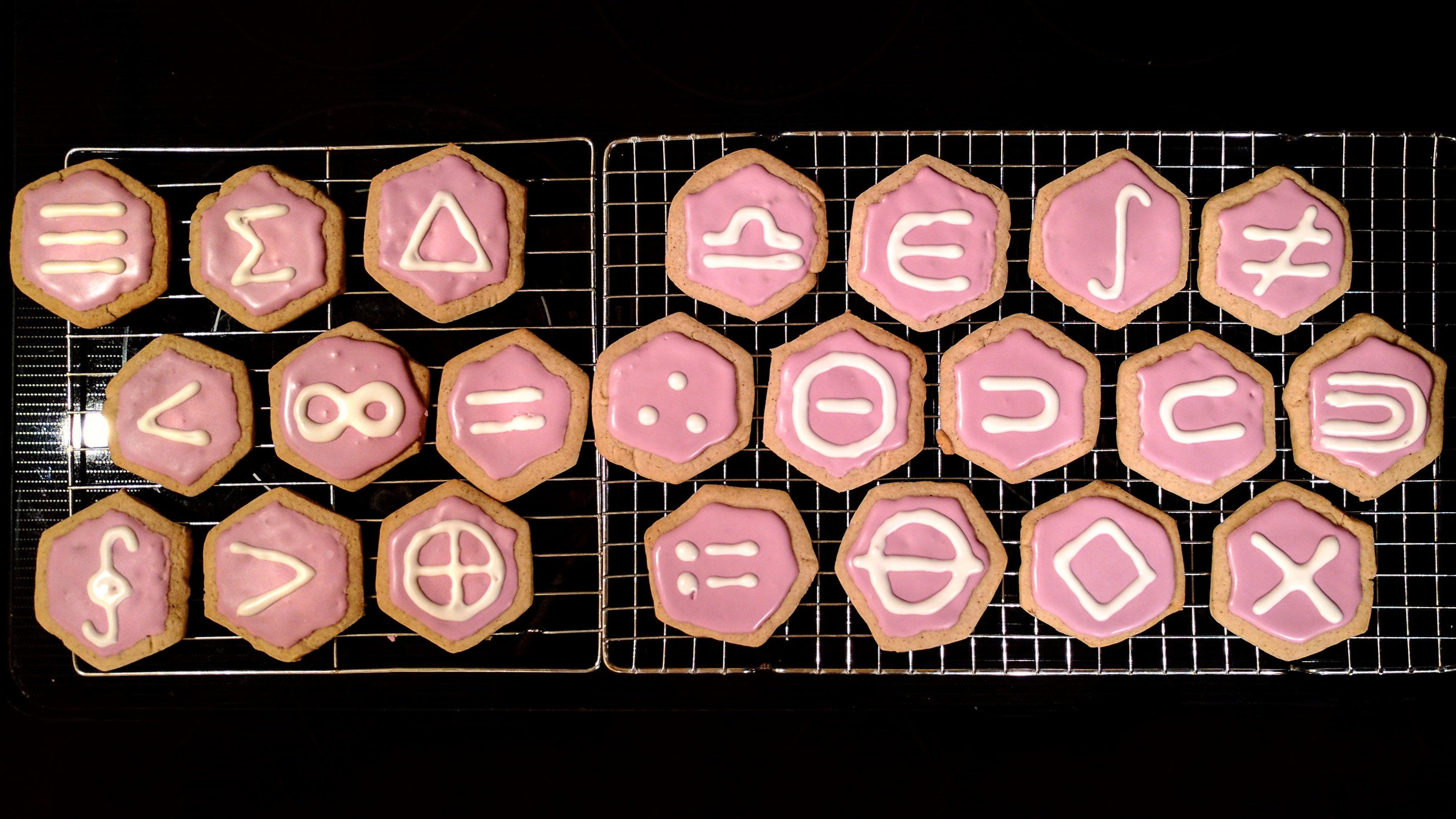 For the last two years, I’ve made Logic Cookies for the National Day of Reason. My first attempt in 2016 resulted in edible cookies but they had numerous problems including less than tasty cookies, soft icing that prevented stacking, and a sub-optimal cookie shape. I’ve patched up most of the issues for 2017 and succeeded well enough that it’s time to release the plans. The 2017 recipes are pretty standard sugar cookie and royal icing recipes with minor tweaks. I changed the cookie shape to hexagonal this year instead of circles. Hexagons are an ideal shape for Logic Cookies because the cookies can be cut with no wastage due to the ability to achieve a perfect 6.6.6 tessellation of the Euclidean cookie dough plane.
For the last two years, I’ve made Logic Cookies for the National Day of Reason. My first attempt in 2016 resulted in edible cookies but they had numerous problems including less than tasty cookies, soft icing that prevented stacking, and a sub-optimal cookie shape. I’ve patched up most of the issues for 2017 and succeeded well enough that it’s time to release the plans. The 2017 recipes are pretty standard sugar cookie and royal icing recipes with minor tweaks. I changed the cookie shape to hexagonal this year instead of circles. Hexagons are an ideal shape for Logic Cookies because the cookies can be cut with no wastage due to the ability to achieve a perfect 6.6.6 tessellation of the Euclidean cookie dough plane.
With the plans below, you’ll be ready to bake your own logic cookies for the next National Day of Reason, which is coming up on 3 May, 2018. If you make some, please comment below and maybe provide a link to your photos!
See more photos of my 2016 Logic Cookies and my 2017 Logic Cookies on Flickr.
Cookie recipe
8 Tbl (35 ml) (1 stick) butter
0.75 cup (177 ml) sugar
1 Tsp (5 ml) baking powder
1 Tsp (5 ml) true cinnamon (Ceylon cinnamon)
0.25 Tsp (1.23 ml) salt
1 egg
1 Tbl (35 ml) milk
1 Tsp (5 ml) Vanilla
2 Cups (474 ml) flour
Beat butter for 30 seconds. Add sugar, baking powder, salt, cinnamon, beat until combined. Add milk, egg, vanilla, beat until combined. Add flour, beating in as much as possible, then finishing with a spoon if needed. Divide dough in half, flatten, cover with was paper and chill in refrigerator for at least 30 minutes.
Preheat over to 375℉. Roll dough on lightly floured surface to 1/4 inch (6.4mm) thick. Cut into 2.5 inch (63 mm) hexagonal shapes. I used Ateco 5251 Plain Edge Hexagon Cutters in Graduated Sizes. Place cookies on non-stick cookie sheet and bake for 8-10 minutes. Cool on wire racks before icing.
Royal Icing recipe
2 cups (226 grams) powdered sugar
1 Tbl (10 grams) meringue powder
1/8 Tsp (0.6 ml) Cream of Tartar
3.5 Tbl (35 ml) water
1 Tsp (5 ml) vanilla extract
1 Tsp (5 ml) light corn syrup (optional for shiny finish on hardened icing)
Food coloring
Combine powdered sugar, meringue powder, and Cream of Tartar with whisk. Add water and vanilla extract. Beat for 10 minutes or until very thick. Separate out a small portion of the icing (approximate 1/8 of it) into a different container for later use in creating the symbols. Add a few drops of your desired food color to the main portion of icing and beat until evenly colored.
Apply color background icing in a thin even coat to each cookie using any preferred icing application method. Let icing cure for at least 10 minutes. Apply the white icing set aside earlier to form logic symbols using your desired method. If you use a piping bag or icing syringe, you will need to thin the white icing with small amounts of water until it reaches a consistency that works with your device of choice.
Let completed iced cookies cure exposed to the air for 12 hours to allow icing to harden.
Symbol table
This is the current collection of symbols I’ve used on my 2016 and 2017 Logic Cookies. I’ve included a variety of symbols from the fields of symbolic logic, set theory, boolean algebra, algebraic logic, and other fields. I also included Gottfried Leibniz’s integral symbol and Leonhard Euler’s summation Sigma. Feel free to expand this list. The follow table uses Unicode values for the symbols so it may not display correctly on older or non-standard web browsers.
∞ Infinity
≔ Definition / Assignment
≡ Material Implication
⊃ Implication / Superset
∪ Union
∩ Intersection
∈ Element of a set
⊆ Subset equal
⊊ Subset not equal
⊂ Subset of
⊇ Superset of
⋑ Double Superset
⨯ Cartesian product
≏ Difference
∅ Empty set
⊖ Symmetric difference
∆ Difference (delta)
∴ Therefore
◇ Possibility
∨ Disjunction
∧ Logical and
⫮ Negation
⊕ Exclusive Disjunction
> Greater than
< Less than
= Equal
≠ Not equal
Σ Sigma (summation)
∫ Integral (Leibniz calculus)
∮ Integral – contour
⨙ Integral – intersection
